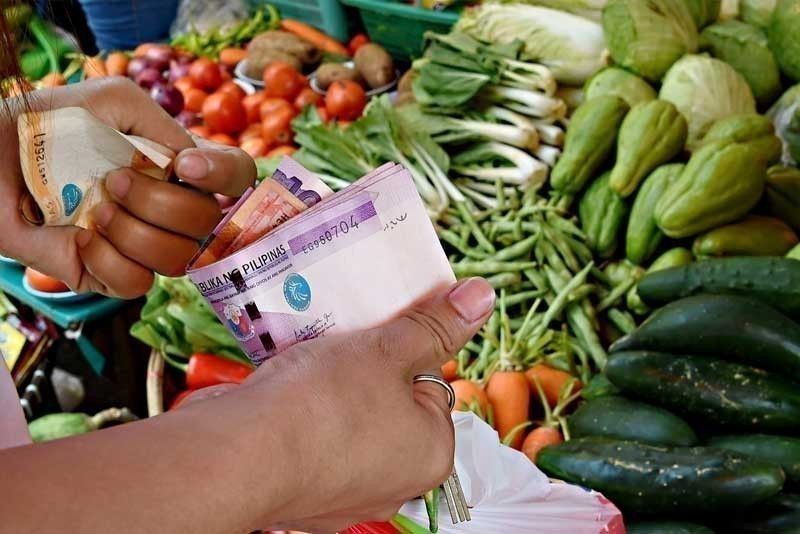Inflation spikes to 4.9%

Highest in nearly 3 years
MANILA, Philippines — Inflation moved at a faster pace in August, jumping to nearly five percent to reach its highest level in almost three years amid more expensive food products and higher energy costs during the month.
Headline inflation, the rate of increase in the price index of the basket of goods and services, soared to 4.9 percent in August from four percent in July. It also breached the 4.4 percent market consensus for the period.
The August inflation is the highest rate recorded in 32 months or since the 5.1 percent clip in December 2018.
The latest print settled at the upper end of the 4.1 to 4.9 percent target band of the Bangko Sentral ng Pilipinas for the month. Year-to-date, inflation registered at 4.4 percent, also above the central bank’s 4.1 percent target for 2021.
In a briefing yesterday, Philippine Statistics Authority chief Dennis Mapa attributed the acceleration to the heavily weighted food and non-alcoholic beverages, which accounted for 77.4 percent of the overall uptrend.
The price index of food and non-alcoholic beverages, which had a 53.1 percent share of the headline rate, jumped to 6.5 percent from 4.9 percent.
In particular, vegetable prices soared to 15.7 percent from five percent, while fish leaped to 12.4 percent from 9.3 percent. Fish inflation, which is also the highest since December 2018, has been a concern since March.
“Fish inflation has been on the rise, it’s not just this month. The double-digit (increase in August) is due to lack of supply and the Department of Agriculture already ordered for the importation of fish,” Mapa said.
For vegetables, Mapa said the overall increase in inflation is due to weather conditions that resulted in crop damages as well as restrictions in certain areas that affected the movement of agricultural products.
Meat inflation also remains a concern after it slightly increased to 16.4 percent from 16 percent the previous month as the presence of African swine fever in the country continues to drag supply and affect prices.
Union Bank of the Philippines chief economist Ruben Carlo Asuncion said inflation at this point should be closely watched.
“I’m no alarmist type but the transitory story of elevated inflation may mean more than it seems,” Asuncion said.
The BSP has been insisting that price pressures are largely transitory, influenced by pandemic-induced changes in spending patterns, increased commodity prices, temporary demand-pull price pressures and base effects.
“If the (non-monetary) measures do not seemingly work as shown by more data, then these may have to be reviewed and corrected if needed,” Asuncion said.
Rizal Commercial Banking Corp. chief economist Michael Ricafort emphasized that food prices tend to go up during the typhoon season especially as food accounts for the biggest chunk in the inflation basket at 35 percent.
With the typhoon season and still low base effects, Ricafort said inflation could reach a peak of five percent by September or October before easing back to three to four percent by the remaining months of 2021.
Also contributing to the inflation were increases in the prices of housing, water, electricity, gas and other fuels, which had a 14.5 percent share of the headline rate. This was driven by rentals, liquefied petroleum gas (LPG) and electricity.
ING Bank senior economist Nicholas Mapa, for his part, said demand-side pressure on inflation was likely muted given that most of the country was under strict mobility restrictions in August.
To curb the elevated inflation, Socioeconomic Planning Secretary Karl Chua said the government is strengthening policy interventions with the Department of Agriculture approving the issuance of a certificate of necessity to import 60,000 metric tons of fish to augment local supply.
The DA is also boosting the hog repopulation program to address the supply gap, as well as promoting urban agriculture and backyard gardening to improve vegetable production.
As granular lockdowns are implemented, Chua said key sectors of the economy must continue to operate and ensure essential goods and services reach consumers.
“Keeping transportation available and affordable, while still following minimum public health standards, will help facilitate the movement of people, goods, and services. All these will allow people to safely earn income and keep prices stable,” he said.
Meanwhile, Mapa said BSP will likely look past the price spike as it continues to vow support for economic recovery.
“Elevated inflation will likely sap some momentum from household consumption in the near term and this will weigh on the Philippine economic recovery,” Mapa said.
“The peso will likely remain pressured in the near term as BSP has signaled that it will not likely adjust policy rates to combat this current spike in prices,” he said.
Moreover, inflation in the National Capital Region surged to 3.7 percent while that of the areas outside NCR rose to 5.2 percent, still on costlier food commodity prices.
On the other hand, consumer prices for the country’s poorest households further accelerated as CPI for the bottom 30 percent income households hit 5.2 percent. This brings the year-to-date average to 4.9 percent.
Faster growth was seen in the index of food and non-alcoholic beverages, particularly vegetables, fish and corn. Increments were also noted in housing, water, electricity, gas and other fuels, and health, among others.
- Latest
- Trending



























